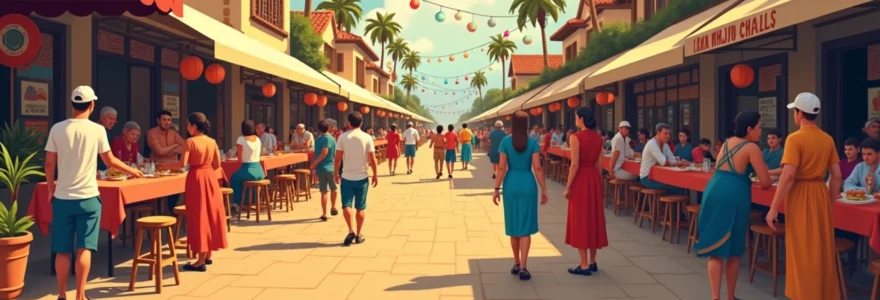Food is more than sustenance; it’s a vibrant expression of cultural identity, history, and tradition. Across the globe, culinary practices intertwine with festivities, creating a rich tapestry of flavours and customs that define communities. From ancient religious ceremonies to modern street food festivals, gastronomic celebrations offer a window into the heart of diverse societies, fostering understanding and connection among people of different backgrounds.
The role of food in cultural celebrations extends far beyond mere nourishment. It serves as a powerful medium for storytelling, preserving ancestral wisdom, and strengthening social bonds. As we explore the myriad ways in which cultures commemorate their heritage through cuisine, we uncover the universal language of food—a dialect that speaks of shared experiences, values, and the human desire for togetherness.
Cultural significance of food festivals worldwide
Food festivals are vibrant showcases of culinary heritage, offering a sensory journey through the tastes, aromas, and traditions of different cultures. These events serve as important cultural ambassadors, allowing both locals and visitors to immerse themselves in the gastronomic delights of a region or community. From the colourful street markets of Southeast Asia to the grand harvest celebrations of Europe, food festivals play a crucial role in preserving and promoting cultural identity.
One of the most significant aspects of food festivals is their ability to bring people together. They create a shared experience that transcends linguistic and cultural barriers, fostering a sense of unity and mutual appreciation. For many communities, these festivals are not just about food; they’re about celebrating collective history, honouring ancestors, and passing down culinary traditions to future generations.
Moreover, food festivals often serve as economic catalysts for local communities. They provide a platform for small-scale producers and artisans to showcase their products, boosting local economies and preserving traditional food-making techniques. This economic impact extends beyond the festival itself, often leading to increased tourism and recognition for regional specialities.
Gastronomic traditions in religious ceremonies
Religious ceremonies and rituals often incorporate specific foods that hold deep symbolic meaning. These culinary traditions not only nourish the body but also feed the soul, connecting worshippers to their faith and community. The preparation and consumption of these ceremonial foods are often steeped in ritual, with every ingredient and cooking method carrying significance.
Diwali’s mithai: symbolism in indian sweets
Diwali, the Hindu festival of lights, is incomplete without an array of mithai , or traditional Indian sweets. These confections are more than just treats; they embody the essence of the celebration. Laden with symbolism, mithai represents the sweetness of life and the victory of good over evil. The sharing of these sweets among family and friends is a gesture of goodwill and an integral part of the festivities.
Popular Diwali sweets include laddu , symbolizing wealth and prosperity, and jalebi , whose circular shape represents the cycle of life. The act of preparing these sweets is often a communal activity, bringing families together and strengthening social bonds. The variety of mithai available during Diwali also showcases the diversity of Indian cuisine, with each region contributing its unique flavours and techniques.
Passover seder plate: ritual foods in judaism
The Passover Seder plate is a centerpiece of Jewish culinary tradition, laden with symbolic foods that retell the story of the Exodus. Each item on the plate carries profound meaning, serving as a tangible link to Jewish history and faith. The maror (bitter herbs) represent the bitterness of slavery, while the charoset (a sweet fruit and nut paste) symbolizes the mortar used by Hebrew slaves in Egypt.
The Seder meal extends beyond the symbolic plate, incorporating other traditional foods like matzo (unleavened bread) and four cups of wine. These elements not only commemorate historical events but also serve to engage all participants in the retelling of the Exodus story. The ritualistic consumption of these foods creates a sensory experience that reinforces cultural identity and religious devotion.
Ramadan iftar: breaking fast in islamic culture
The Iftar meal, which breaks the daily fast during the Islamic holy month of Ramadan, is a time of spiritual reflection and community gathering. Traditionally, the fast is broken with dates and water, following the example of Prophet Muhammad. This simple act carries deep religious significance and sets the tone for the communal meal that follows.
Iftar menus vary across the Muslim world, reflecting local culinary traditions while adhering to Islamic dietary laws. Common dishes include hearty soups, fresh fruits, and special Ramadan sweets like qatayef . The act of sharing Iftar with family, friends, and even strangers is an important aspect of Ramadan, embodying the values of charity and community that are central to Islam.
Easter feast: christian culinary customs
Easter celebrations in Christian traditions often feature a feast that symbolizes the end of Lenten fasting and the joy of resurrection. The Easter meal varies widely across cultures but typically includes foods with religious significance. In many Western countries, lamb is a central dish, representing Christ as the “Lamb of God.” Easter breads, such as the Greek tsoureki or the Italian colomba pasquale , are often shaped to symbolize aspects of Christian faith.
Eggs, a universal symbol of new life, play a prominent role in Easter culinary traditions. From the elaborately decorated Easter eggs of Eastern Europe to the chocolate eggs popular in many countries, these treats represent renewal and rebirth. The Easter feast, with its rich symbolism and communal nature, serves to reinforce Christian faith and cultural identity.
Seasonal harvest celebrations and local cuisines
Harvest festivals are among the oldest forms of cultural celebrations, marking the rhythms of agricultural cycles and the bounty of the earth. These events not only honour the fruits of labour but also showcase the unique flavours and culinary traditions of different regions. Seasonal harvest celebrations often feature dishes made from freshly gathered produce, highlighting the connection between land, community, and cuisine.
Oktoberfest: bavarian beer and culinary heritage
Oktoberfest, originally a Bavarian wedding celebration, has evolved into the world’s largest beer festival and a showcase of German culinary traditions. While beer takes center stage, the festival’s food offerings are equally important in representing Bavarian culture. Traditional dishes like Schweinebraten (roast pork), Würstl (sausages), and Sauerkraut are staples of the celebration, offering visitors a taste of authentic German cuisine.
The festival’s food traditions go beyond mere sustenance; they are a celebration of Bavarian identity and craftsmanship. The Brezel (pretzel), for instance, is not just a snack but a symbol of Bavarian baking tradition. Oktoberfest’s culinary offerings demonstrate how seasonal celebrations can preserve and promote regional food heritage on a global stage.
Thanksgiving: north american autumn harvest feast
Thanksgiving in North America is perhaps one of the most iconic harvest celebrations, deeply rooted in historical narrative and cultural tradition. The feast centres around the turkey, a native American bird, accompanied by a variety of side dishes that reflect the autumn harvest. Pumpkin pie, cranberry sauce, and stuffing are not just menu items but cultural symbols that evoke nostalgia and national identity.
The Thanksgiving meal is more than just a feast; it’s a ritual that brings families and communities together. The tradition of sharing this meal with loved ones reinforces social bonds and cultural values. Moreover, the incorporation of regional variations and family recipes into the Thanksgiving menu demonstrates how this holiday continues to evolve while maintaining its core cultural significance.
Olivagando: italian olive oil festival in umbria
Olivagando, held annually in the Umbrian town of Magione, Italy, celebrates the olive harvest and the production of new oil. This festival is a testament to the central role that olive oil plays in Italian cuisine and culture. Visitors can participate in olive picking, witness traditional oil pressing methods, and sample freshly pressed oils paired with local specialities.
The festival not only showcases the culinary uses of olive oil but also educates visitors about its production, quality assessment, and cultural significance. Tastings and cooking demonstrations highlight the versatility of olive oil in Italian cuisine, from simple bruschetta to complex pasta dishes. Olivagando exemplifies how a single ingredient can be the focal point of a cultural celebration, uniting gastronomy, agriculture, and tradition.
Songkran: thai new year water festival and traditional dishes
Songkran, the Thai New Year celebration, is renowned for its water festivals but also features a rich culinary tradition. The holiday’s food customs reflect Thai values of family, respect for elders, and spiritual renewal. Special dishes prepared during Songkran often have symbolic meanings and are offered to Buddhist monks as a way of making merit.
Traditional Songkran foods include khao chae , a refreshing dish of rice soaked in flower-scented water served with various side dishes, symbolizing purity and coolness. Kanom tom , sweet coconut balls, represent unity and family bonds. The preparation and sharing of these special foods during Songkran reinforce cultural identity and social connections, demonstrating how culinary traditions are integral to festive celebrations.
Street food festivals: global culinary exploration
Street food festivals have emerged as vibrant platforms for culinary exploration and cultural exchange. These events bring together diverse food traditions, offering attendees a gastronomic journey around the world without leaving their city. From bustling night markets in Asia to trendy food truck festivals in Western cities, street food celebrations showcase the creativity and diversity of global cuisines.
These festivals not only satisfy culinary curiosity but also serve as important cultural bridges. They provide opportunities for immigrant communities to share their culinary heritage and for locals to experience authentic flavours from around the globe. Street food festivals often highlight fusion cuisines, reflecting the dynamic nature of culinary traditions in an increasingly interconnected world.
Moreover, street food festivals play a crucial role in preserving and promoting local food cultures. They often feature traditional dishes that might not be found in restaurants, keeping alive recipes and cooking techniques that might otherwise be lost. For many small-scale food entrepreneurs, these festivals provide a vital platform to showcase their creations and build a customer base, contributing to the vibrancy of local food scenes.
Ethnographic analysis of communal dining practices
Communal dining practices offer deep insights into social structures, cultural values, and historical traditions of different societies. Ethnographic studies of these practices reveal how food serves as a medium for social interaction, reinforcing community bonds and cultural identity. From the elaborate tea ceremonies of Japan to the communal tajine meals of Morocco, shared dining experiences are rich with symbolic meaning and social significance.
Mediterranean meze: shared small plates culture
The meze culture of the Mediterranean and Middle East exemplifies the social nature of communal dining. Meze, a selection of small dishes served as appetizers or a meal, encourages sharing and conversation. This dining style reflects cultural values of hospitality, community, and leisurely enjoyment of food and company.
Ethnographic analysis of meze culture reveals how it fosters social cohesion and reinforces cultural identity. The act of sharing dishes creates a sense of intimacy and equality among diners. The variety of meze offerings also showcases the diversity of local ingredients and culinary traditions, serving as a tangible expression of regional heritage.
Chinese lunar new year: symbolism in festive dishes
The Chinese Lunar New Year feast is a prime example of how communal dining practices can embody cultural beliefs and aspirations. Each dish served during this celebration carries symbolic meaning, often related to wishes for prosperity, longevity, and good fortune in the coming year. For instance, dumplings shaped like ancient Chinese gold ingots symbolize wealth, while long noodles represent long life.
The preparation and consumption of these symbolic dishes are deeply communal activities, bringing together multiple generations of family members. Ethnographic studies of Lunar New Year celebrations highlight how these culinary traditions serve to reinforce family bonds, cultural values, and connection to ancestral heritage.
Brazilian feijoada: national dish and social cohesion
Feijoada, Brazil’s national dish, is more than just a meal; it’s a social event that reflects the country’s history and cultural diversity. Traditionally served on Saturdays, feijoada brings together family and friends for a leisurely lunch that often extends well into the afternoon. The dish itself, a hearty stew of black beans and various meats, has roots in the country’s colonial past and slave trade history.
Ethnographic analysis of feijoada gatherings reveals how this communal meal serves as a unifying force in Brazilian society. The preparation and consumption of feijoada bridge social and economic divides, creating a shared cultural experience that reinforces national identity. The ritualistic nature of these gatherings, with specific side dishes and serving order, demonstrates how culinary traditions can encode cultural values and social norms.
Native american potlatch: feast of abundance and Gift-Giving
The potlatch ceremony, practiced by indigenous peoples of the Pacific Northwest, is a complex feast and gift-giving ritual that plays a crucial role in social, economic, and political structures. These elaborate gatherings, which can last for days, involve the distribution of wealth, conferring of social status, and reaffirmation of family and tribal ties.
Ethnographic studies of potlatch ceremonies reveal how food serves as a medium for social exchange and cultural continuity. The abundance of food prepared and shared during potlatches symbolizes the host’s wealth and generosity. The specific foods served, often including salmon, berries, and game meat, reflect the rich natural resources of the region and the traditional knowledge required to harvest and prepare them.
Culinary tourism: food as cultural ambassador
Culinary tourism has emerged as a powerful form of cultural exchange, allowing travellers to experience a destination through its flavours, cooking techniques, and dining customs. This form of tourism goes beyond mere consumption; it offers immersive experiences that deepen understanding of local cultures and traditions. From cooking classes and food tours to farm visits and wine tastings, culinary tourism provides multi-sensory engagement with a destination’s heritage.
Food serves as an effective cultural ambassador, breaking down barriers and fostering connections between visitors and local communities. Culinary tourists often gain insights into a region’s history, geography, and social structures through its cuisine. For example, exploring the terraced vineyards of Portugal’s Douro Valley not only offers a taste of fine wines but also illuminates centuries of agricultural tradition and the impact of geography on local culture.
Moreover, culinary tourism plays a vital role in preserving and promoting traditional foodways. By creating demand for authentic, local experiences, it encourages communities to maintain and celebrate their culinary heritage. This can lead to the revival of traditional recipes, the preservation of artisanal food production methods, and the economic empowerment of local food producers and artisans.
As culinary tourism continues to grow in popularity, it also raises important questions about sustainability and cultural authenticity. Responsible culinary tourism seeks to balance the desires of visitors with the needs of local communities, ensuring that food traditions are respected and preserved rather than commodified or diluted. When done thoughtfully, culinary tourism can be a powerful tool for cultural preservation, economic development, and cross-cultural understanding.


